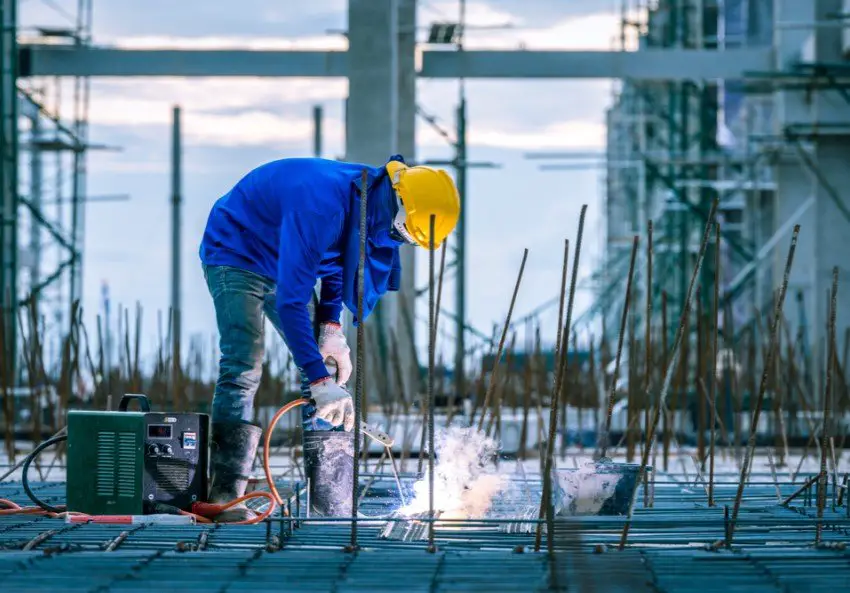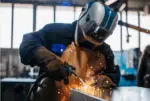Welding is a profession that requires binding different metals with the help of heat, and since heat is involved, you cannot be careless with your PPEs and safety attires. This means wearing clothes that are recommended to use while you’re working with heat.
Cotton is made entirely of natural fibres, which are highly recommended for welding since they are less flammable and simpler to extinguish than synthetic fibres.
Cotton welding apparel, more specifically, flame-resistant (FR) cotton clothing that has been chemically treated also offers cost-effective protection against flames, sparks, and molten splash.
What Are Flame Resistant (FR) Fabrics?
Flame-resistant (FR) fabrics are those that do not easily catch fire or melt when exposed to fire or extreme heat, which is why they are ideal while doing welding work.
Inherently flame-resistant fabrics and chemically treated flame-resistant fabrics are the two main types of FR materials. Fabrics that are inherently flame-resistant have a chemical composition that renders them resistant to fire.
And chemically treated flame-resistant fabrics are flame-resistant because a flame-resistant chemical is applied to them, the underlying fabric may or may not also be flame resistant.
According to Advanced Occupational Health and Safety Jurisdictions, employees are required to wear flame-resistant materials in workplaces with severe fire dangers, like welding.
Fabrics with verified fire resistance are referred to as “FR-rated” in America.
A fabric product must be evaluated by an authorized testing facility to be classified as FR-rated.
Wool, Kevlar, and Nomex are examples of common flame-resistant materials.
And chemically treated FR fabrics are often constructed of cotton or poly-cotton blend and are less costly than intrinsic FR materials but they just have a small issue, they’re not durable because they wear out faster.
Aside from cost and durability, chemically treated textiles typically outperform most intrinsic FR materials in terms of molten metal splash resistance.
See also: Is FR (Flame Resistant) Clothing Good for Welding?
Benefits Of Cotton While Welding
1.) Cotton fabrics are safe with fire- Cotton burns cooler than synthetics, meaning if you wear a cotton shirt that catches fire, you will be able to easily pat it out with your glove.
2.) Cotton is good for protection while welding- In applications where sparks and spatter are generally moderate, a FR cotton jacket can provide a decent balance of protection and comfort.
3.) Cotton is comfortable- Flame resistant cotton is popular because it is relatively inexpensive, lightweight and breathable which will keep your body cool and comfortable while welding.
4.) Cotton is hypoallergenic in nature- Welding involves working with heat which produces sweat. And it is this sweat that causes irritation and discomfort because it might lead to rashes and skin allergies.
Therefore, wearing cotton clothes will keep the body free of rashes and allergies as it lets your skin breathe.
5.) Cotton is low maintenance- While welding, a lot of sparks are produced which might damage a lot of your clothing.
It is a good thing that cotton isn’t expensive so replacing it will not burn a hole in your pockets. But just make sure you protect your skin from the burns.
6.) Cotton is a versatile fabric- Not just for shirts, cotton can also be used to make other apparels like welding shirts, pants, jackets and gloves that are flame resistant.
Apart from Cotton, there are other fabrics, like Leather and Denim, that can be worn by Welders while Welding. Let us read more on them.
Leather
Due to its density, leather has traditionally been regarded as the greatest welding protective material as it does not let sparks burn your skin.
The thickness of the leather prevents heat from permeating the garment while also providing outstanding abrasion and puncture resistance keeping your body safe from welding hazards.
There are several leather varieties, cuts, and grades that are available, all of which can affect the product’s quality and cost, as well as overall comfort and mobility.
1.) Grain leather- The strongest layer of an animal’s skin is the top layer, which is known as grain leather. They may be manufactured considerably thinner than the undersides of the hide, making it lighter and more comfortable.
Grain leather clothes are good for welding because they resist sparks and splatter keeping you safe overall.
2.) Split leather- Split leather, which is formed from the underside of the hide, is another type of leather used in welding jackets.
Split leather has a fuzzy appearance and feel, and while it is less costly, this type of leather is heavier, thicker, and more porous to dirt and grease.
Denims
Denims are excellent welding materials. They are ideal for welding since they are resistant to heat and they protect against flames, molten metal, and sparks.
They will keep you safe from burn damage too. Because welding denims are heavy-duty, they might feel a little heavy while wearing it to work.
Nomex
Nomex is a DuPont product that has better flame resistance and will actually inflate when flames or sparks come into contact with it, shielding the welder and protecting the skin from burns.
The FR characteristics of Nomex clothes will never wash off and will save you against all sparks that are produced while welding. This means you don’t have to chemically FR treat them often or even purchase frequently.
Safety Welding Apparels Where Cotton is Used
1.) Jackets- If you reside in a hotter region, you know that welding outside in the summer may be very painful. Mostly because welding in a T-shirt is a bad idea as sparks may set it on fire, and spatter can be even worse for your skin.
And when the temperature approaches 100°F, wearing a leather welding jacket is not an option as it will make you sweaty and uncomfortable.
And that is why fire-resistant cotton came to the limelight. It won’t last long when subjected to frequent grinding and welding, but it will cover your skin and protect it well enough.
And the only leather item you can bear during summers is your glove and boots.
2.) Aprons- Welding aprons made of FR cotton is not only lightweight and comfortable, but they’re also durable against welding sparks and flames.
They may not be as sturdy and durable as leather aprons, but they do their job pretty great when it comes to keeping your lower body protected against heat and flame.
3.) Lowers / Pants- Pants made of cotton not only keeps you cool and comfortable during summers, but it also lets your skin breathe. FR cotton pants are designed to keep you safe and protected from welding hazards.
4.) Welding Sleeves– In some cases, welding sleeves are used instead of a full jacket. Welding sleeves, like jackets, are available in a number of materials, including FR cotton and blends, which combines the protection of leather with the lightweight breathability of cotton.
5.) Welding Hats And Bandanas: These products can be worn beneath a welding helmet for added protection and comfort, but make sure they are made of cotton since they are worn beneath and need to be breathable.
FAQs-
Why should you not wear synthetic fabrics like Polyester and Nylon while welding?
Polyester and nylon are not flame resistant, and they dissolve and pull away from the flame rather than catching fire.
And when these materials catch fire, they burn slower than cotton and tend to melt, causing more damage to your skin.
Is Cotton really safe while welding?
FR cotton apparels are considered safe while welding as they’re breathable and don’t catch fire easily. Also they’re lightweight and keep you comfortable which is an added benefit while welding which is considered a pretty tough job.
However, keeping all this in mind, we should also remember that while cotton apparels are considered safe, they’re not as safe as leather, which is more sturdy and durable.
Conclusion
There are countless benefits of cotton fabrics, and when it comes to protective clothing made of cotton, they sure are comfortable but they aren’t as safe as leather.
But it doesn’t mean it lets your skin burn. It offers decent protection against all welding hazards and that is why we recommend FR cotton apparels while welding.








